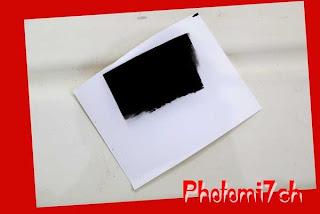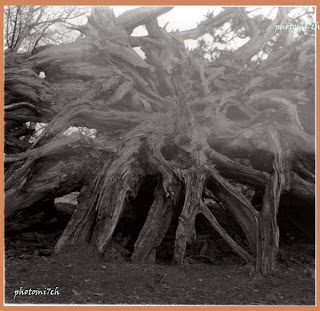Recently,
I had an unexpected back log of film to process It can be
difficult to find the time to do them especially when it is more than
a couple of rolls. Anyway a gap opened up so I dived into the
darkroom to load two of the rolls ready for development. As I
reached for the RO9 my attention was attracted to a couple of bottles
of developer standing behind it. RO9 Special and Studional which as
it turns out are one and the same along with Rodinal Special. While I
was boxing up the first couple of film I had a rush of blood to the
head and decided to give the RO9 Special a try. There was method in
my madness.
At
the time of my decision I had no background knowledge of this
developer apart from how it was marketed and the information on the
side of the bottle which is sparse to say the least. The blurb stated
that RO9s was the finer bread brother of RO9 which was what attracted
me to it in the first place. Part of my madness had been influenced
by a cassette of HP5+ I had been given to process.
 |
| 120 FP4+ Negs Developed in RO9s |
In
stead of jumping in at the deep end with both feet, I thought it
prudent to check the very short developing times printed on the side
of the bottle by processing a roll of 120 FP4+. Because I have a
tendency to slightly under expose my negatives the suggested time of
three and a half minutes at a dilution of 1 to 15 was increased to
four. I used my standard agitation method of twelve inversions for
the first thirty seconds and then four every minute. As there was no
indication to the contrary. As soon as the fix was poured out of the
tank I checked to see if they had developed properly. From what I
could see they looked perfect. I had not intended to do a grain
comparison for this film, it was purely to see if the times on the
bottle worked in my favour.
The
info on the side of the bottle for HP5+ suggested four minutes at
1+15 - I processed the film for five; as it turns out it was a good
move. I think the negatives would have been a bit thin otherwise.
I
have now researched process times and developer information for RO9s
Something I should have done first with a visit Digital truths Dev chart for more times. They tell you to look at Studional.
 |
| HP5+ Negs developed in RO9s |
Something
else I had not been aware of was once the developer had been made up
you could use it again. I had a suspicion it could be used again
because the concentrate had a syrupy look when I poured it out. In
fact you can process up to twelve rolls of mixed formats per litre.
The most interesting thing about this developer is that there is no
time compensation if you do more than one roll of film on the same
day. You only add a compensation factor the longer the working
developer in stored. Up to three months.
Developer
Data:
RO9
Special/Rodinal Special and Studional.
Characteristics: Fine grain
sharp negatives with good contrast. Once diluted can be stored for
multiple use. Short process times.
Mixing
instructions: Dilute
concentrate with water 1+15
Number
of Film per Dilution: 10-12
35mm or 120 format per Litre.
Temperature:
Is best kept between 18 C and
24C with + or – adjustments as needed to the length of the
development time.
Agitation:
Tilt the tank for the first
minute continuously and then once every minute. You should avoid
developing times under three minutes.
Shelf
Life: Concentrate should last 2
years in original bottle with no air gap. Once Diluted it should last
3 months without air gap in it's own container.
Time
increases for multiple use: To
keep speed yield and contrast consistent the diluted developer should
be kept in brim full tightly capped bottles if this is achieved the
following will apply:
Idle
time between
two
batches
|
Development
lengthened
by
|
few
hours (but development none *on same day)
|
None
*
|
1
– 3 days
|
5.00%
|
4
– 8 days
|
10.00%
|
1
– 2 weeks
|
15.00%
|
over
2 weeks
|
20.00%
|
* with Atomal FF: + 10
%.
The
extra times given above do not change if several films are
simultaneously
processed in one batch.
Suggested
development times for use with RO9 special, Rodinal Special and
Studional:
Film
type
|
Time
*
|
Speed
|
Agfapan
APX 100
|
4
min
|
ISO
100/21°
|
Agfapan
APX 400
|
6
min
|
ISO
400/27°
|
Fuji
Neopan 400 Prof.
|
3
min
|
ISO
320/26°
|
Fuji
Neopan 1600 Prof.
|
3
min
|
ISO
800/30°
|
Ilford
PAN-F Plus
|
3
min
|
ISO
50/18°
|
llford
FP 4 Plus
|
3.5
min
|
ISO
100/21°
|
Ilford
HP 5 Plus
|
4
min
|
ISO
400/27°
|
Ilford
Delta 100
|
3.5
min
|
ISO
160/23°
|
Ilford
Delta 400
|
4.5
min
|
ISO
400/27°
|
Ilford
Delta 3200
|
6
min
|
ISO
1250/32°
|
Ilford
SFX 200
|
4
min
|
ISO
125/22°
|
Kodak
Plus-X
|
5
min
|
ISO
125/22°
|
Kodak
Tri-X
|
3.5
min
|
ISO
400/27°
|
Kodak
T-MAX 100
|
5
min
|
ISO
80/20°
|
Kodak
T-MAX 400
|
5
min
|
ISO
400/27°
|
Kodak
T-MAX p3200
|
6
min
|
ISO
1250/32°
|
Kodak
Recording 2475
|
6
min
|
ISO
640/29°
|
Almost
forgot the reason for the rush of blood to the head if you had not
already guessed it was to do with the 35 mm HP5+ I find that this
films emulsion tends to produce rather grainy negatives with standard
RO9. As I intend to enlarge these negatives to 9 x12 the finer
developer should make the prints less grainy. I am pleased to say
the strategy worked, the negatives have a much finer grain than the
standard RO9. The proof of the pudding will be in the printing of the
FP4+ and HP5+ negatives. I will share more prints in another post.
 |
| 9 x 12 photograph from 35mm HP5+ negatives developed in RO9 special |
 Talking
of new year resolutions photograph wise - have you set any? I don't
as a rule but this year is going to be different I have two things I could like to achieve one I have already mentioned the other is to
spend more time in the darkroom printing, something that I can neglect. I find it difficult to spend anytime at all during the summer months in the darkroom I o not like wasting time inside if
the weather is bright and warm, even in the evenings. I suspect I'm
not the only one. What are your thoughts?
Talking
of new year resolutions photograph wise - have you set any? I don't
as a rule but this year is going to be different I have two things I could like to achieve one I have already mentioned the other is to
spend more time in the darkroom printing, something that I can neglect. I find it difficult to spend anytime at all during the summer months in the darkroom I o not like wasting time inside if
the weather is bright and warm, even in the evenings. I suspect I'm
not the only one. What are your thoughts?


























